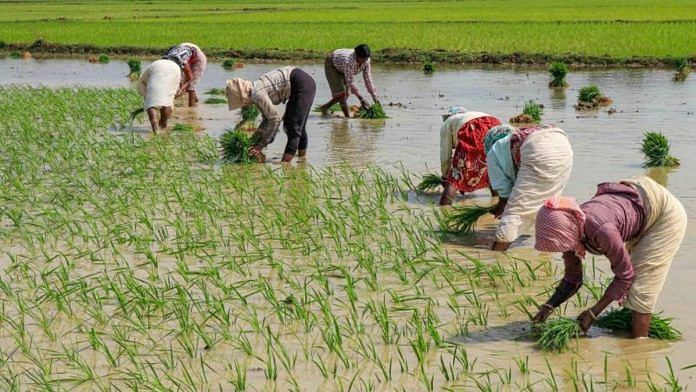New Delhi: On 8 September, India, the world’s largest exporter of rice, announced export curbs to tame spiralling retail prices. The move was anticipated because lower and delayed planting, in the face of deficit rainfall, are estimated to hit production.
The Modi government had in May imposed a ban on wheat shipments after a heatwave led to a lower harvest.
India accounts for a 40 per cent share in the global rice trade of around 50 million tonnes. ThePrint takes a close look at why export restrictions have been imposed on certain varieties of rice.
Export curbs announced so far
India has imposed a 20 per cent duty on export of all varieties of rice, except basmati and parboiled rice, with effect from 9 September. In addition, it has imposed a complete ban on export of broken rice, which is a by-product of the milling process.
Together, basmati (4 million tonnes) and parboiled rice (7.4 million tonnes) accounted for 54 per cent of India’s total rice exports of 21.2 million tonnes in 2021-22. The rest, about 10 million tonnes of rice exports from India, including broken and raw rice, and about a fifth of the global trade in rice, has been restricted so far.
Also read: Keep calm and carry on: Unlike wheat, rice isn’t hot yet
Why export of broken rice is banned
In 2021-22, India exported about 3.9 million tonnes of broken rice, primarily to China, which uses it as animal feed. The high exports created a shortage in India, where broken rice is used for manufacturing ethanol and as cattle feed.
Between April and August 2022, India has already exported 2.1 million tonnes of broken rice, which is again higher than previous years. Other than China, some poorer African countries like Senegal and Djibouti also import broken rice from India, but for human consumption.
How export of broken rice impacted India
According to data shared by the food ministry, domestic industry manufacturing ethanol and animal feed is struggling to ensure availability of broken rice at a reasonable price. Due to robust exports, the price of broken rice shot up to Rs 22 per kg in early September from Rs 16 per kg in early January — a 27 per cent increase in just eight months.
India has targeted to blend 20 per cent ethanol with petrol by 2025, which cannot be met only with sugar-based feedstock, which is why grain-based (maize and broken rice) feed stocks have been allowed since 2018-19.
Moreover, according to a statement issued by the food ministry, the poultry and animal husbandry sectors have been hit hard due to the hike in feed prices. So, to contain the impact on milk, egg and poultry prices, it was imperative to ban broken rice exports.
Can govt announce more export curbs?
The Centre is expecting a hit of 6-12 million tonnes to rice production due to uneven rains, compared to the target Kharif production of 112 million tonnes. Any future restrictions will depend on actual production and how domestic prices move.
As on 11 September, wholesale and retail rice prices were higher by 13 per cent and 9 per cent, respectively, year-on-year.
“On the whole, (public) rice stocks should remain above buffer levels, but current export restrictions may not necessarily improve the demand-supply situation materially, implying that there remains an upside risk to rice prices. As such, we believe there is a risk that further curbs on rice exports could be imposed, particularly in categories still exempted,” Japanese think tank Nomura Research said in a note Monday.
(Edited by Nida Fatima Siddiqui)
Also read: Good news from the farm as India’s FY22 foodgrain production estimated at record 316 mn tonnes



